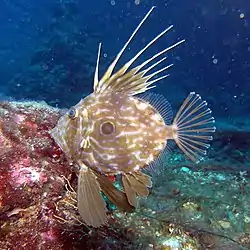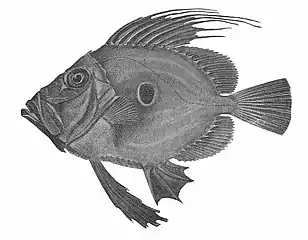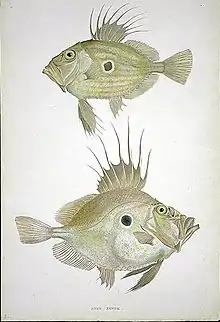John Dory
John Dory, St Pierre or Peter's fish, refers to fish of the genus Zeus, especially Zeus faber, of widespread distribution. It is an edible demersal coastal marine fish with a laterally compressed olive-yellow body which has a large dark spot, and long spines on the dorsal fin. Its large eyes at the front of the head provide it with binocular vision and depth perception, which are important for predators. The John Dory's eye spot on the side of its body also confuses prey, which are scooped up in its big mouth.[3][4]
| John Dory Temporal range: | |
|---|---|
 | |
| Zeus faber | |
| Scientific classification | |
| Domain: | Eukaryota |
| Kingdom: | Animalia |
| Phylum: | Chordata |
| Class: | Actinopterygii |
| Order: | Zeiformes |
| Family: | Zeidae |
| Genus: | Zeus |
| Species: | Z. faber |
| Binomial name | |
| Zeus faber | |

In New Zealand, Māori know it as kuparu, and on the East Coast of the North Island, they gave some to Captain James Cook on his first voyage to New Zealand in 1769. Several casks of them were pickled.[3]
Etymology
Various, often doubtful explanations are given of the origin of the name. It may be an arbitrary or jocular variation of dory (from French dorée, gilded), or an allusion to John Dory, the hero of an old ballad. Others suggest that "John" derives from the French jaune, yellow. The novel An Antarctic Mystery by Jules Verne gives another account, which has some popularity but is probably fanciful: "The legendary etymology of this piscatorial designation is Janitore, the 'door-keeper,' in allusion to St. Peter, who brought a fish said to be of that species, to Jesus at his command." Other known names for the John Dory are the "St. Pierre", or "Peter's Fish", perhaps explaining why dories were often referred to as "Peter Boats", Saint Peter being the patron saint of fishermen.[5] A related legend says that the dark spot on the fish's flank is St. Peter's thumbprint.[6] In the north coast of Spain, it is known commonly as San Martiño. The Māori language name for the fish, kuparu, appears to be unique to New Zealand, as there are no cognates found in other Polynesian languages.[7]
Morphology

The John Dory grows to a maximum size of 65 cm (2 ft) and 5 kg (12 lb) in weight. It has 10 long spines on its dorsal fin and 4 spines on its anal fin. It has microscopic, sharp scales that run around the body. The fish is an olive green color with a silver white belly and has a dark spot on its side. Its eyes are near the top of its head. It has a flat, round body shape and is a poor swimmer.
Prey and predators
The John Dory catches prey by stalking it, then extending its jaw forward in a tube-like structure to suck the fish in with some water. The water then flows out through the gills; the pre-maxillary bone, the only tooth-bearing bone in this fish, is used to grind the food.
The John Dory has a high laterally compressed body – its body is so thin it can hardly be seen from the front. The large eyes at the front of the head provide it with the binocular vision and depth perception it needs to catch prey. This eye spot also confuses prey, which can then be sucked into its mouth.[8]
It primarily eats smaller fish, especially schooling fish such as sardines. Occasionally it eats squid and cuttlefish.
Its main predators are sharks such as the dusky shark, and large bony fish.
Habitat
John Dory are benthopelagic coastal fish, found on the coasts of Africa, South East Asia, New Zealand, Australia, the coasts of Japan, and on the coasts of Europe. They live near the seabed, living in depths from 5 to 360 metres (16 to 1,200 ft). They are normally solitary. John Dory are more commonly found in the waters of the North Island of New Zealand, than the colder waters surrounding the South Island.[7]
Reproduction and lifespan
When John Dories are 3 or 4 years of age, they are ready to reproduce. This happens around the end of winter. They are substrate scatterers, which means that they release sperm and eggs into the water to fertilize. Typical lifespan is about 12 years in the wild.
As food
The cookery writer Eliza Acton observes in her 1845 book, Modern Cookery for Private Families, that John Dory "though of uninviting appearance, is considered by some person(s) as the most delicious fish that appears at [the] table". She recommends simply baking it "very gently", avoiding drying it out in the oven.[9]
John Dory is a popular choice among professional chefs for seafood due to the versatility of the fish, however, access to home cooks is limited as it is not typically sold at supermarkets due to its status as bycatch.[10]
References
- Sepkoski, Jack (2002). "A compendium of fossil marine animal genera". Bulletins of American Paleontology. 363: 1–560. Archived from the original on 2011-07-23. Retrieved 2007-12-25.
- Iwamoto, T. (2015). "Zeus faber". IUCN Red List of Threatened Species. 2015: e.T198769A42390771. Retrieved 2 November 2021.
- New Zealand Coastal Fish: John Dory.
- Bray, Dianne. "John Dory, Zeus faber". Fishes of Australia. Archived from the original on 6 April 2017. Retrieved 24 August 2014.
- see 1:Charlotte Mary Yonge, History of Christian names, Volume 1, pg. 359// 2: Abraham Smythe Palmer "Folk Etymology; Verbal Corruptions Or Words Perverted In Form Or Meaning pg. 196// 3.David Badham, Prose halieutics: or, Ancient and modern fish tattle/ 4: American Notes and Queries, Volume 3 pg. 129// and 5: Fraser's Magazine For Town And Country, January To June 1853
- The legend is noticed in Stéphan Reebs, Fish Behavior in the Aquarium and in the Wild (Cornell 1991:36); Reebs notes that the fish does not occur in the Sea of Galilee, where Peter fished.
- Vennell, Robert (5 October 2022). Secrets of the Sea: The Story of New Zealand's Native Sea Creatures. HarperCollins Publishers Ltd. pp. 188–191. ISBN 978-1-77554-179-0. Wikidata Q114871191.
- Walrond, Carl (2006) Coastal fish - Fish of the open sea floor, Te Ara: Encyclopedia of New Zealand. Accessed 28 May 2019.
- Acton, Eliza (1860) [1845]. Modern Cookery for Private Families. Longman, Green, Longman, & Roberts. p. 58.
- Staff (8 December 2014). "How to cook John Dory". Great British Chefs. Retrieved 22 June 2023.
Sources
 This article incorporates text from a publication now in the public domain: Wood, James, ed. (1907). "Dory, John". The Nuttall Encyclopædia. London and New York: Frederick Warne.
This article incorporates text from a publication now in the public domain: Wood, James, ed. (1907). "Dory, John". The Nuttall Encyclopædia. London and New York: Frederick Warne.
External links
 Media related to Zeus faber at Wikimedia Commons
Media related to Zeus faber at Wikimedia Commons- Article on the British Sea Fishing forum: http://britishseafishing.co.uk/john-dory/
- Photos of John Dory on Sealife Collection
